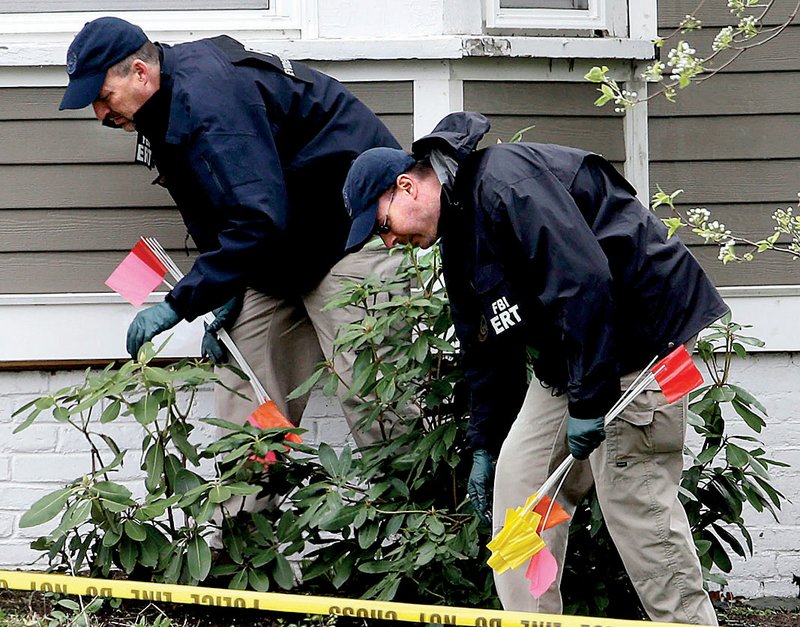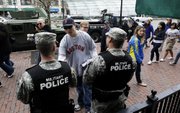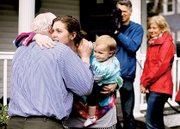WASHINGTON - With one suspect dead and the other captured and lying grievously wounded in a hospital, the investigation into the Boston Marathon bombings turned Saturday to questions about the men’s motives, and to the significance of an overseas trip one of them took last year.
Massachusetts Gov. Deval Patrick told reporters at Fenway Park on Saturday that Dzhokhar Tsarnaev’s condition was “serious but stable” and that he was “not able to communicate.” Tsarnaev was at Boston’s Beth Israel Deaconess Medical Center, where 11 victims of the bombing were still being treated.
As of Saturday, more than 50 victims of the bombing remained hospitalized, three in critical condition.
“I, and I think all of the law enforcement officials, are hoping for a host of reasons the suspect survives,” the governor said after a ceremony at Fenway to honor the victims and survivors of the attack. “We have a million questions, and those questions need to be answered.”
Boston Marathon explosions
A series of explosions at the Boston Marathon killed two people and injured several on April 15, 2013.
Watch VideoAgents who brought Dzhokhar Tsarnaev were concerned about the amount of blood he lost before he was taken into custody after an almost 24-hour manhunt that shut down Boston and surrounding cities, a federal law enforcement official said.
Authorities believe the two bombing suspects were acting alone and so far haven’t found connections to any groups or other suspects, said a person briefed on the investigation who asked not to be identified because it is a continuing probe.
Federal investigators are hurrying to review a visit that one of the bombing suspects made to Chechnya and Dagestan, predominantly Muslim republics in the north Caucasus region of Russia. Both have active militant separatist movements. There are concerns in Congress about the FBI’s handling of a request from Russia before the trip to examine the man’s possible links to extremist groups in the region.
Tamerlan Tsarnaev, who died early Friday after a shootout with police in Watertown, Mass., spent six months of last year in Dagestan.
Tamerlan’s father, Anzor, said his son had returned to renew his passport, but his stay was prolonged and, analysts said, may have marked a crucial step in his path toward the bombing of the Boston Marathon.
The investigators began scrutinizing the events in the months and years before the fatal attack, as Boston began to feel like itself for the first time in nearly a week.
The bombing Monday, near the finish line of the Boston Marathon, killed three and wounded scores, and the tense days afterward culminated in Friday’s lockdown of the entire region as police searched for Dzhokhar Tsarnaev from suburban backyards to an Amtrak train bound for New York City, taking him into custody later that night.
The motivations of Tamerlan and Dzhokhar Tsarnaev are as yet publicly unknown. Of Chechen heritage, they lived in the United States for years, according to friends and relatives, and no direct ties have been publicly established with known Chechen terrorist or separatist groups.
The significance of the trip was magnified late Friday when the FBI disclosed in a statement that in 2011 “a foreign government” - now acknowledged by officials to be Russia - asked for information about Tamerlan, “based on information that he was a follower of radical Islam and a strong believer, and that he had changed drastically since 2010 as he prepared to leave the United States for travel to the country’s region to join unspecified underground groups.”
But the FBI never followed up on Tamerlan Tsarnaev once he returned, a senior law enforcement official acknowledged on Saturday, adding that the bureau had not kept tabs on him until he was identified on Friday as the first suspect in the marathon bombing case.
Russia and the United States have since 1994 routinely exchanged requests for background information on residents traveling to each other’s countries on visa, criminal or terrorism issues. It was unclear Saturday whether Russia makes requests of any American traveler of Chechen origin to Russia, or if the Russian government offered the FBI specific evidence in the case of Tamerlan Tsarnaev.

The bureau responded to the request by checking “U.S. government databases and other information to look for such things as derogatory telephone communications, possible use of online sites associated with the promotion of radical activity, associations with other persons of interest, travel history and plans, and education history,” the statement explained.
In January 2011, two agents from the bureau’s Boston field office interviewed Tamerlan and family members, a senior law enforcement official said Saturday. According to the FBI’s statement, “The FBI did not find any terrorism activity, domestic or foreign,” and conveyed those findings to “the foreign government” by the summer of 2011.
As the law enforcement official put it, “We didn’t find anything on him that was derogatory.”
The Russian state news agency RIA Novosti quoted the father of the Tsarnaev brothers recalling the FBI’s close questioning of his elder son, “two or three times.”
In an interview in Russia, Zubeidat Tsarnaeva, the mother of the two men, recalled that the agents had told her that Tamerlan was “an excellent boy,” but “at the same time, they told me he is getting information from really extremist sites, and they are afraid of him.”
After the visit to Dagestan and Chechnya, signs of alienation emerged. One month after Tamerlan returned to the United States, a YouTube page that appeared to belong to him was created and featured multiple jihadi videos that he had endorsed in the past six months.
The aftermath of the arrests has thrust Washington and Moscow into a cooperative mode, a jarring shift coming amid weeks of rancor over American criticism of Russia’s human-rights record. Obama and Russian President Vladimir Putin spoke by telephone late Friday night, in a conversation initiated by the Russian side, the Kremlin announced. The Kremlin’s statement said both leaders expressed “the building of close coordination between Russian and American intelligence services in the battle with global terrorism.”
Nevertheless, there were glaring questions about the case, among them how Tamerlan had escaped attention after 2011.
A Russian intelligence official told the Interfax news service on Saturday that Russia had not been able to provide the United States with “operatively significant” information about the Tsarnaev brothers, “because the Tsarnaev brothers had not been living in Russia.”
On Saturday morning, federal prosecutors were drafting a criminal complaint against Dzhokhar Tsarnaev, who was wounded in the leg and neck and had lost a great deal of blood when he was captured Friday evening. The FBI and local law enforcement agencies continued to gather evidence and investigate the bombings, the slaying of a Massachusetts Institute of Technology police officer Thursday night and the subsequent battle with the police that left another officer critically wounded.
RELATED ARTICLES
http://www.arkansas…">Brothers’ family often uprooted in search for stable, safe lifehttp://www.arkansas…">Debate stirred over refusal to Mirandize bomb suspecthttp://www.arkansas…">Slain officer popular at MIT
An official said the criminal complaint would likely include a constellation of charges stemming from both the bombings and the shooting, possibly including the use of weapons of mass destruction, an applicable charge for the detonation of a bomb. That charge, the official said, carries a maximum penalty of death. While Massachusetts has outlawed the death penalty, federal law allows it.
In other news, the University of Massachusetts Dartmouth remained closed as law enforcement officials continued their investigation into Dzhokhar Tsarnaev.
The university said in a written statement Saturday that campus and law enforcement officials continue“logistical and investigative operations.”
In Washington, Obama met Saturday with top national security officials to discuss the Boston Marathon investigation and Tsarnaev’s capture.
The White House said Obama convened the National Security Council midday for a 90-minute meeting in the White House Situation Room. Attorney General Eric Holder, FBI Director Robert Mueller and other officials briefed Obama on the investigation. Vice President Joe Biden joined by video conference.
The White House said Obama emphasized the need to keep gathering intelligence to answer lingering questions about the terrorist attack.
Meanwhile, a doctor involved in treating Tamerlan Tsarnaev said he had injuries head to toe and all limbs intact when he arrived at the hospital.
Dr. David Schoenfeld said Tsarnaev was unconscious and had so many penetrating wounds when he arrived at Beth Israel Deaconess Medical Center early Friday that it isn’t clear which ones killed him, and a medical examiner will have to determine the cause of death.
Tsarnaev’s clothes had been cut off by emergency responders at the scene, so if he had been wearing a vest with explosives, he wasn’t by the time he arrived at the hospital, the doctor said.
“From head to toe, every region of his body had injuries,” he said. “His legs and arms were intact - he wasn’t blown into a million pieces” - but he lost a pulse and was in cardiac arrest, meaning his heart and circulation had stopped, so CPR, or cardio-pulmonary resuscitation, was started.
After 15 minutes of unsuccessful treatment, doctors pronounced him dead.
Information for this article was contributed by Eric Schmitt, Michael S. Schmidt, Ellen Barry, John Schwartz,Andrew Roth, David M. Herszenhorn, Peter Baker and C.J. Chivers of The New York Times; by Phil Mattingly, Mike Dorning, Julie Bykowicz, Douglas Lavanture, Esme E. Deprez, Micha Rondeau, David McLaughlin, Tom Moroney, Brian K. Sullivan, Kathleen M. Howley, Annie Linskey, Angela Zimm, Margaret Talev, Justin Blum, Oliver Staley, Stepan Kravchenko, Henry Meyer and Bill Faries of Bloomberg News; and by Bridget Murphy, Katie Zezima, Denise Lavoie, Steve Peoples, Colleen Long, Pete Yost, Eric Tucker and Jimmy Golen of The Associated Press.
Front Section, Pages 1 on 04/21/2013



